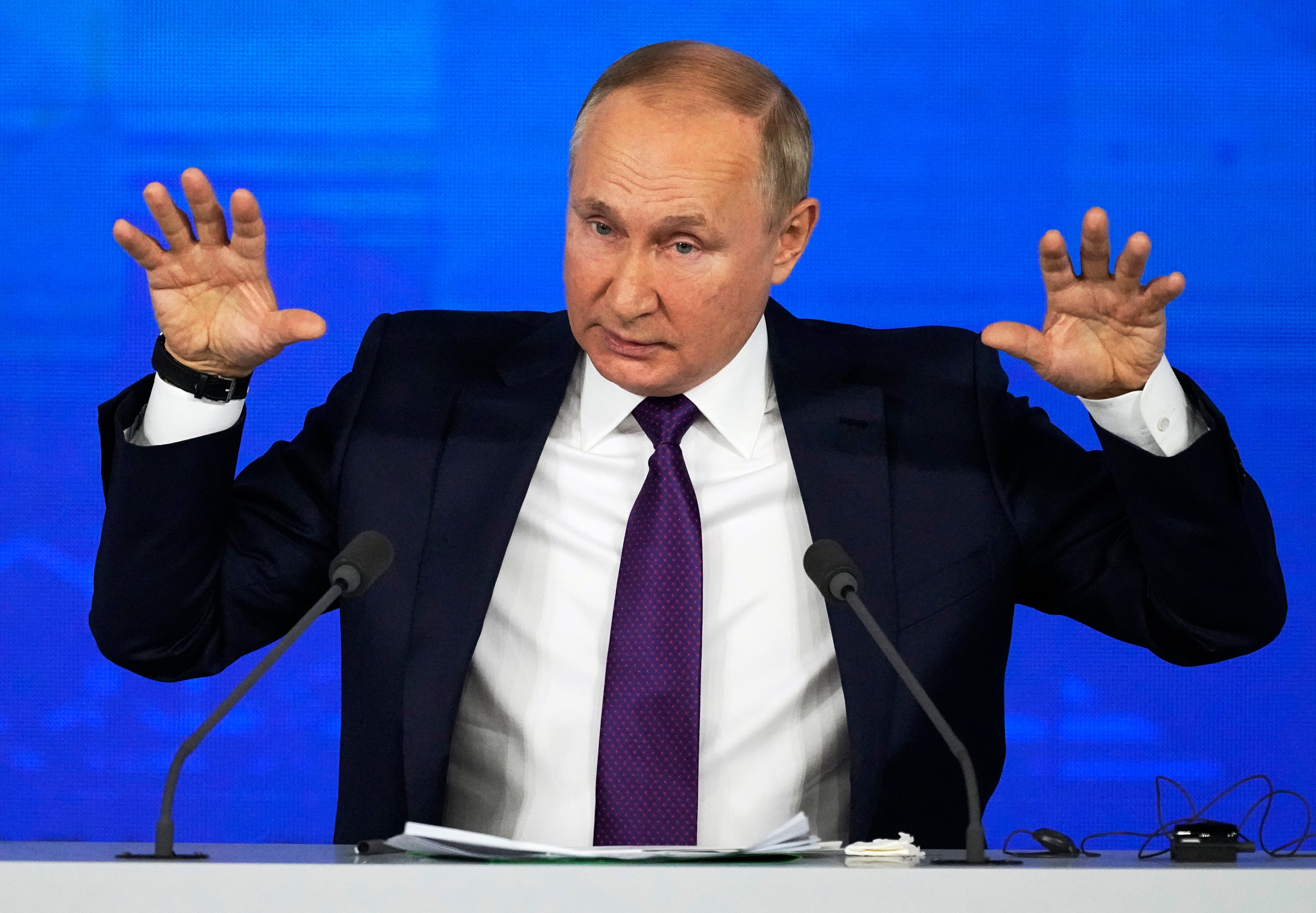Vladimir Putin has made clear to Joe Biden and Nato what he wants
The Russian president has put out a supposed diplomatic ‘ultimatum’ in the form of two draft security treaties, writes Mary Dejevsky


In Russia’s recent relations with the west, Vladimir Putin’s patience seems to run out every seven years.
In 2007, seven years after he became interim president of Russia, he used a speech at the annual Munich Security Conference to denounce the expansion of Nato as a threat to Russia’s security and a betrayal of western assurances. Seven years later, in 2014, he responded to what Russia saw as a western-inspired uprising in Ukraine by snatching Crimea and incorporating it into Russia.
And now, seven years on again, he has put out a supposed “ultimatum” in the form of two draft security treaties, one for the consideration of the United States, the other for Nato.
Of all these three demarches, these proposed treaties must be judged the most positive – which might seem a strange judgement, given the current western alarm over a possible Russian invasion of Ukraine. The point is, though, that for most of the past 20 years, a consistent complaint of western governments and Russia-watchers has been that they don’t know what Putin wants. Now, there can be no excuses for not knowing.
Russia’s Ministry of Foreign Affairs has spelt it out in no uncertain terms in two draft agreements. All President Joe Biden, and at least half of all Nato members (the “half” is Russia’s stipulation) have to do is turn up at Geneva or wherever, and sign. Which, of course, is not going to happen.
In many ways, these documents are regressive. They hark back to a time – the late Cold War – when the US and Russia were bound into a series of highly codified arms treaties, and the Helsinki Final Act, which stipulated common rights and responsibilities on both sides of the east-west divide. This reflects a widely-held Russian view that the divide once symbolised by the Berlin Wall has not, as they had hoped, been eliminated, but merely moved east to Russia’s post-Soviet border.
Jens Stoltenberg, on Nato’s behalf, has already ruled the agreements out of court, and there is much – some would say the whole concept – that would be rejected by most individual Nato members. The United States, though, has refrained from a knee-jerk rejection, suggesting that, while Biden will not be rushing to sign up, there could be the basis for discussion.
And he is right. There are. Most of all though, what Russia is proposing makes clear and public, for the first time that I can remember, what exactly Russia has been worried about all this time.
The drafts contain three main demands. One is for the US, Nato and Russia to be bound by common conditions on the stationing and movements of troops and military capacity to keep them away from either side of what is now the Russia-west border in Europe. This is designed to prevent the sort of incidents (including the spat between British and Russian warships in the Black Sea in the summer), as well as troop build-ups close to the border, that could lead to accidental war.
The second looks, at first sight, as though Russia wants to reverse Nato’s eastward expansion. But the actual demand is for no foreign Nato troops or weapons to be stationed on the territory of the ex-Soviet members. This would be tantamount to restoring – in practice, if not name – the guarantees that Russia believes it was given after the dissolution of the Warsaw Pact. Russia’s third, very explicit demand is related: a formal undertaking from the US and Nato that there will be no more expansion of the alliance, and specifically, that Ukraine will not join.
In principle, this last stipulation will not even be a starter. The Nato line has long been that no third party can exercise a veto on any aspect of what it does. The practice, however, could be different. As far back as 2008, Nato was split over enlargement to Georgia and Ukraine, and a fudged promise was given to the effect that membership was not ruled out. If US enthusiasm for expansion has now cooled, further enlargement will be off the agenda – though if Russia hopes for this to be enshrined in a treaty, it will be disappointed.
And while Nato – with the “new” Nato members in the vanguard – will also resist to the hilt any limit to deployments of US and other foreign troops in those countries that joined after 1997, there could still be room for discussion. Nato members are divided over engaging or isolating Russia, and there are some influential voices in the United States now warning that, in expanding to the east, Nato has given an unwise hostage to fortune in terms of Article 5 – that an attack on one member is treated as an attack on all. This protection is largely why the Baltic States and former Warsaw Pact members were so keen to join Nato, but would Americans, realistically, support their troops going to war with Russia over, say, Estonia?
All that said, however, it is surely wrong to treat Russia’s draft treaties as any more than an opening gambit – with the timing reflecting either Moscow’s exasperation with the west’s failure to recognise what it sees as Russia’s legitimate security concerns, primarily over Ukraine, or Putin’s hope that, in Biden, he is facing a US president with whom – for the first time in a while – he can do business. The two have been in regular contact since their formal Geneva summit in June, and recently spent two hours on a Zoom call. Experts are reportedly beavering away in working groups. At the very least, the draft treaties give them more to talk about.
Perhaps the most useful aspect of these drafts, however, is the way – coincidentally perhaps – they reflect Russia’s fears. Nato always insists that it is a defensive alliance – so Russia has nothing to fear, however close it might come to Russia’s borders. What these draft treaties show is that Russia sees Nato’s advance as aggressive, and a possible prelude to western designs on Russia itself.
From the perspective of Washington or London or even Berlin, such trepidation might seem fanciful, even absurd. From Moscow, however, as these treaties make clear, Ukraine as a Nato member is seen as a springboard for a western advance into Russia itself. All the west’s talk of a Russian threat to invade Ukraine has its mirror-image: a direct western threat to Russia from Nato’s new front line.
If the west finally understands this, progress towards greater security in Europe could be possible. And there are positives in some of what Russia is proposing. De-escalation on either side of the border would apply to Russia too. Moscow also appears to have accepted the fact of Nato expansion thus far; its problem is with countries, such as Poland and the Baltic States – and Ukraine – hosting US and other foreign Nato troops and the hardware they bring with them. A Poland, say, with a Polish army trained and equipped to Nato standards and contributing to Nato missions as and when, would seem to be accepted. The drafts also accept Nato as the negotiating partner for security in Europe.
At the very least, these documents bring new clarity to how and why Russia feels the need for security guarantees. At once more specific and less ambitious than the grand security plan proposed by the then-Russian president, Dmitry Medvedev, back in 2009, they represent Russia’s wish list, no more. Now the United States and Nato need to produce theirs – and start talking seriously for the first time in years.






Join our commenting forum
Join thought-provoking conversations, follow other Independent readers and see their replies
Comments